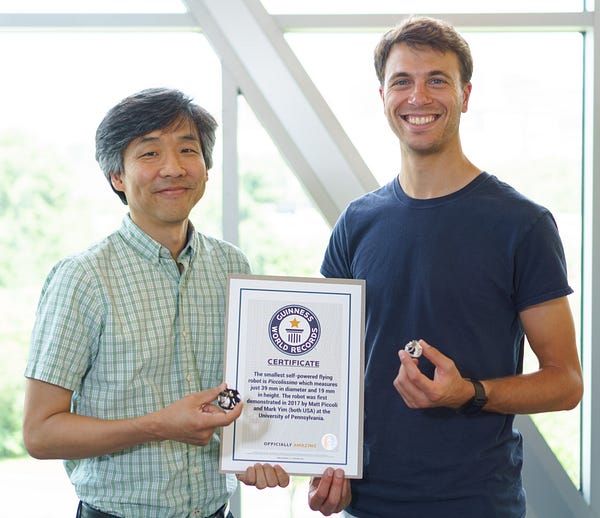Guinness Recognizes Piccolissimo as World’s Smallest Self-Powered Flying Robot

Guinness World Records has officially recognized Piccolissimo as the World’s Smallest Self-Powered Flying Robot.
Italian for “tiniest,” Piccolissimo is the brain child of Matt Piccoli, a graduate student in professor Mark Yim’s ModLab. The robot comes in two sizes; the smaller weighs less than 2.5 grams and is about the width of a quarter, while the larger, steerable version is about 2 grams heavier and a centimeter wider.
The string of adjectives qualifying Piccolissimo as the “smallest” is necessary due to the concerted effort in miniaturizing flying robots. Harvard’s RoboBee, for example, is a few millimeters smaller than the steerable Piccolissimo, but is tethered to a terrestrial power source, limiting its range of motion.
Enabling directional control on such a tiny frame is an equally big challenge, but one that the ModLab is particularly equipped to address. One of the lab’s specialties is “underactuated” robots, ones that achieve the greatest range of motion with the fewest motors possible.
To that end, Piccolissimo has only two moving parts: a propeller and the body of the robot itself. Made out of light, 3D-printed plastic, Piccolissimo’s body spins in the opposite direction as the propeller. Precisely timed speed changes, controlled by an infrared signal, can therefore turn the robot one way or another.

“The body spins around 40 times per second, while the propeller spins about 800 times per second,” Piccoli says.“Since the propeller is mounted off-center on the vehicle body, the propeller’s center, and therefore the location of its thrust, also spins around 40 times per second. If we increase the propeller speed every time the body is facing ‘6 o’clock’ and slow down the propeller every time the body faces ’12 o’clock,’ the average torque tries to turn the body towards ’12 o’clock.’”
While Piccolissimo’s small size limits how much it can carry — about a gram’s worth of payload — it is enough for a small camera or other types of sensors. Piccoli also thinks that the robot’s unique mode of locomotion could be an asset in this area as well.
“Spinning vehicles are pretty terrible for carrying people, but pretty fantastic for carrying sensors,” Piccoli says. “It’s common practice to make a simple sensor, then spin it around, like radar dishes at airports. We get this feature for free, so we could take a line-scan camera, like in a barcode reader, put it on the vehicle body, and get a 360-degree panorama. These cameras are simpler and smaller than a normal 2D camera, and yet we’d get a better field of view.”
